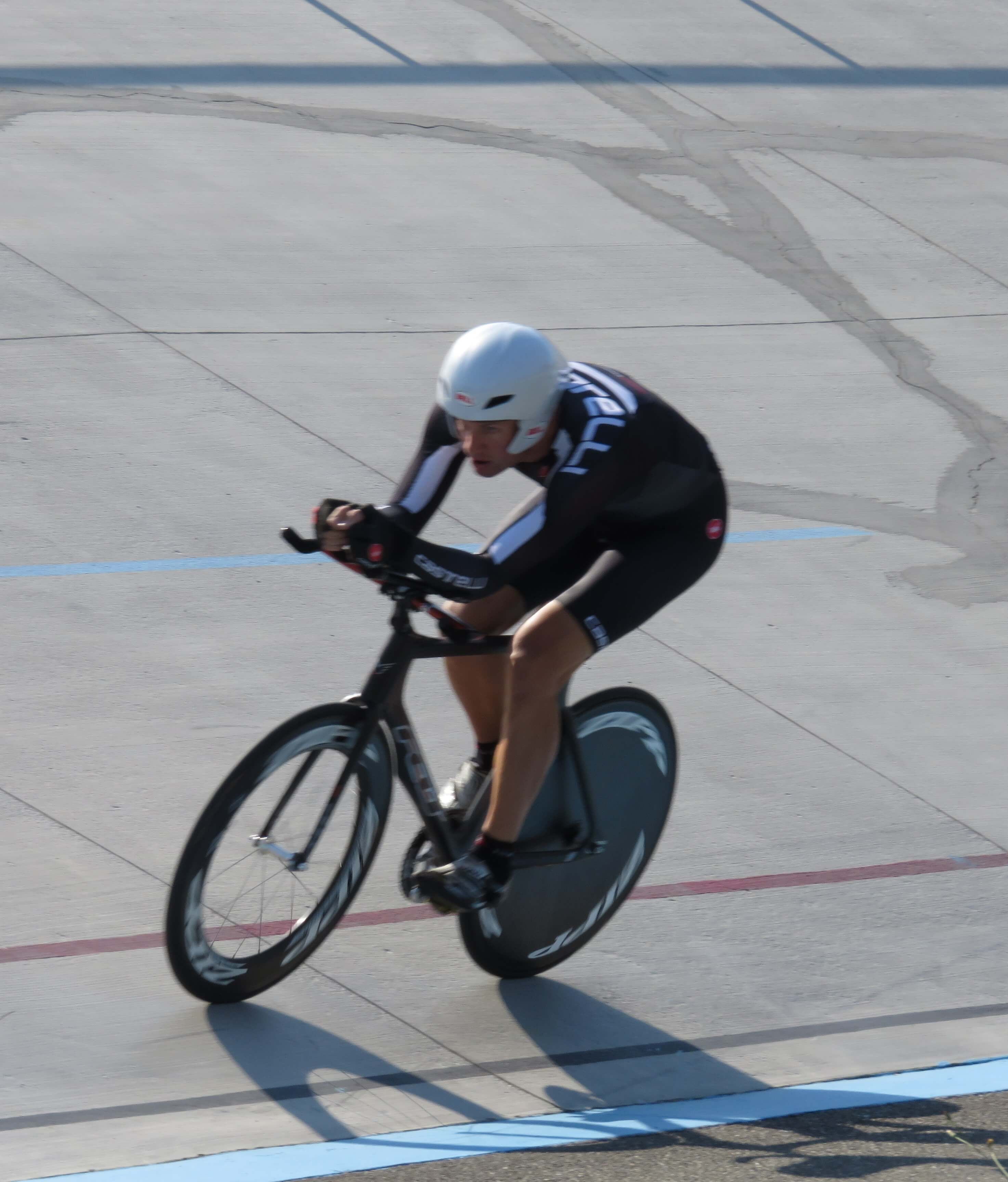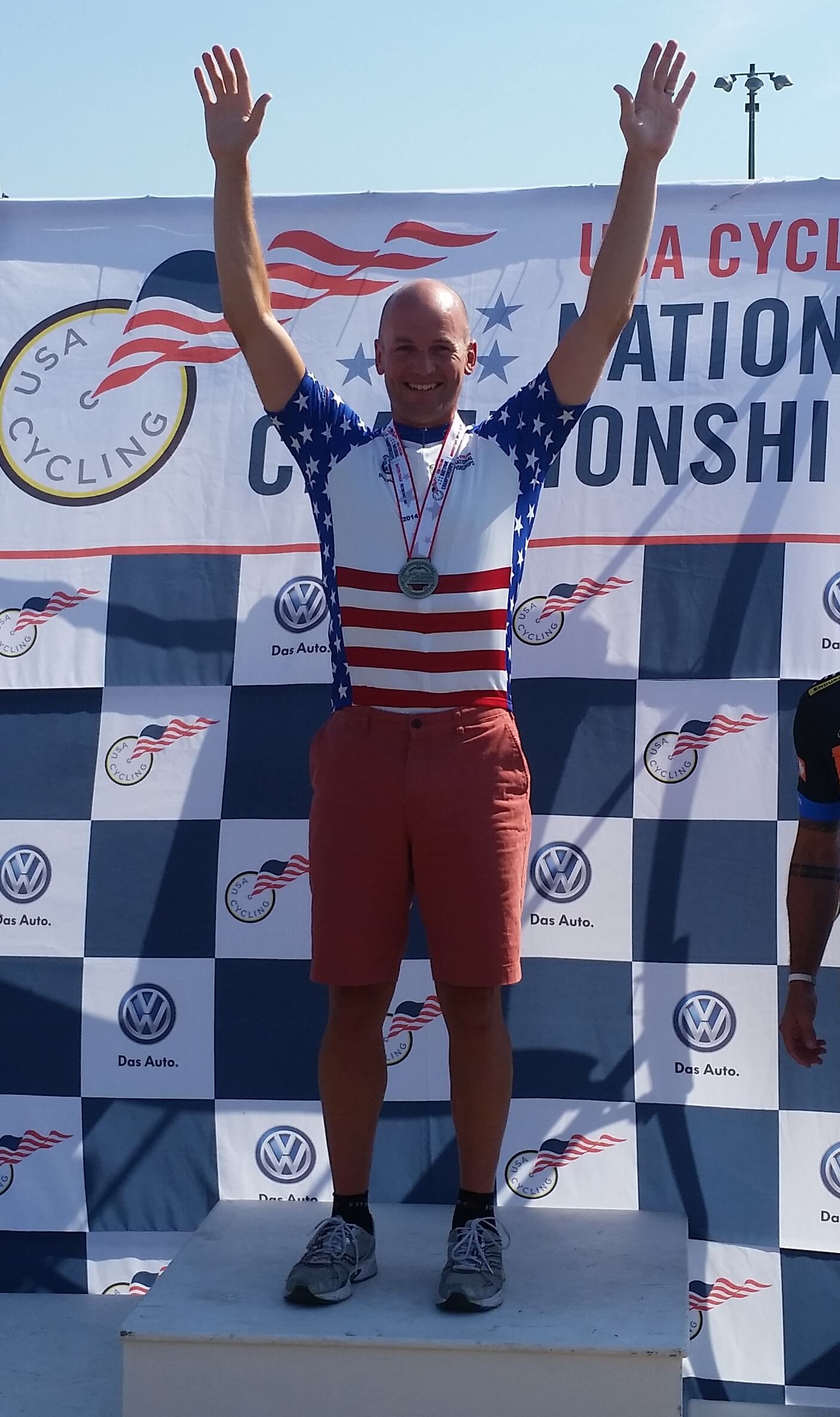Dean's 3k Individual Pursuit Race Report – National Champion!
This past weekend I competed at the USA Cycling Masters Track National Championships in the 3000 meter Individual Pursuit. For my many non-track-cycling friends this is basically a 2-mile individual time trial on a fixed gear bike in a banked velodrome from a standing start – yet dig down a little bit and there’s a lot more to it. The event itself has always fascinated me since it’s so simple yet so complex at the same time. While I’ve never ridden in a velodrome before, I prepared for this event the best I could off the track and felt confident going in. I’ve always wanted to race the pursuit since it matches up well with my strengths. The nationals were just outside Seattle this year which is where my brother Eben and his family live. I stayed with them over the weekend, and Eben quickly transformed into a pro mechanic and cycling coach during the event which removed a lot of stress from the event and added lots of fun! I was able to get on the velodrome for a few minutes the day before to practice riding at speed through the banked turns which gave me some peace of mind that they wouldn’t be any trouble on race day.
The Race
I was in the 1st heat paired with another rider on the opposite side of the velodrome. On the bright side there weren’t any times to worry about yet and I could just focus on my own race. Riders in the later heats however can adjust their pacing schedule around the earlier posted times, but I had enough to think about already. My opponent fall started after the first countdown, so we immediately got called back to restart. The 2nd start was clean, the gun fired, and we were off. We’d ride 7.5 laps of the 400-meter Marymoor Velodrome.
I yanked and pushed my 52×13 gear as hard as I could for a few pedal strokes, stood and accelerated through the first banked turn, and then settled into my aerobars on the opposite straightaway. The standing acceleration through this first banked turn was one of several areas I was worried about, so it was a relief to be through it. I held back and cruised through the next lap as planned. I knew through many time trials and practicing starts that my perceived effort would lie to me early on and while I felt like I was cruising I was still pushing hard. The race then became a concentration-fest of focusing on keeping my bike between the black and red lines on the straights and turns while spinning 105rpms as lactic acid quickly filled every muscle in my body. If I strayed just above the outer red line the track bank shifts to a shallower angle – typically sending you even further up the bank – and if I strayed inside the black line I’d hit the cushions or flat surface of the track which had its own consequences… I chose to aim exactly between the two lines for the next 3 minutes!
Eben was taking lap splits each time I passed the finish, and calling them out to me as I passed him on the opposite side. We planned our “pro” timing system beforehand by copying what other coaches where doing. A 400-meter lap split of 28.3 seconds would be called out as “eight, three” when I passed him, and I’d presumably adjust my pace as needed. I knew through practice and outdoor simulations that 28-second laps would keep me near my power target and would give me a good chance for the fastest time. My first full lap was 28.1, so I was right where I needed to be.
Sometime around the halfway point I had to pass my opponent. The entire pass would happen on the banked turn, and I gave him some extra room since I didn’t want any chance of contact. The pass went smoothly, and I waited until I was well ahead of him before moving back to the inside lane. I didn’t know if there were rules about how soon I could move in front of him and there wasn’t much time to think about it!
Laps 3-5 went by smoothly. Eben was calling out splits at or just over 28 seconds, and I kept focusing on staying between the two lines which if I didn’t know better appeared to be getting closer to each other each lap.
As I passed the 2 laps to go sign, I made a conscious effort to start pushing the pace as hard as I could knowing there was less then a minute to go. It was more like a decision to push as hard as I could – while still properly steering my now swerving bike through banked turns as I kept my eyes glued to the two lines that now looked only inches apart. I kept the pace high as the bell rang for my final lap, and heard Eben call out 27.6 seconds for that lap. I knew I was moving now and fought through screaming muscles to keep spinning as fast as I could the last lap. I remembered feeling relieved when I rounded the final bend to the straightaway – knowing all I had to do was steer the bike straight on a flat track through the finish. I crossed the finish, and then sat up as I climbed up the banking to start slowing the bike down. I coasted a couple laps before finally pulling off. Eben timed my last lap at 27.5 seconds and my official time was 3:38.2. It was a huge relief on so many levels to be done with it and have a great time, so now it was time to anxiously wait the rest of the heats. Nobody in the 40-44 or 45-49 age groups had gone under 3:40 earlier in the week, so things were looking good as my time was the fastest of the week so far and we were the last age group to race.
A rider in the final heat – Chris Schiller – matched my time for the first 1km, then again through 2km which got the announcer fired up, until falling off the pace the last couple laps to finish in second at 3:42. 3rd, 4th, and 5th place were all within a few seconds of that time.
I immediately was swept away to doping control which I found was impressively thorough. All race winners and a number of random numbers were picked for doping control at this event. The fact that USA Cycling has embraced clean racing and invested in this testing was a big factor in my decision to finally travel to nationals. It gives me a lot of peace of mind knowing that I’m racing against clean riders at these events.
I was awarded the Stars and Stripes jersey at the awards ceremony, and they have you put it on before stepping up on the podium for the medals. Here’s an action shot from the pursuit as well. I was certain those red and black lines were closer together then they appear in that shot!
Gearing
I used a 52×13 gear which is on the big side for this event. The perfect gear for the pursuit needs to be small enough to accelerate up to speed quickly from a standing start, but also big enough to turn over at top speed. Too big a gear will cost you precious time accelerating up to speed from a standing start, and too small a gear will leave you spinning out at top speed. I experimented with a range of gearing leading up to the event, and in the end found I could handle this gear well both from a standing start and also at top speed. I also leaned toward a gear closer to what I’d push in a road time trial since I didn’t have much time to adapt to the higher cadences you’ll typically see on the track.
Pacing
The perfect pacing for the pursuit will have you reaching maximum speed after the standing start, while slowly losing speed throughout the rest of the event. The fastest kilometer for a well-paced 3k event will be the middle km with the last km being 1-2 seconds slower when studying the fastest times. The first km will always be slower because of the standing start. Based on my time splits I went 1:18, 1:11, and 1:09 for each kilometer so clearly went faster at the end. I don’t have great data for my first half-lap of the 7.5 lap race, but my last 6 laps were right around 28 seconds each. I was happy with how fast I went on the day, but in the future working on the standing start, and picking up the pace earlier in the middle km of the race are areas to shave fractions of a second.
This strava link has my speed and power data for the event. Computer displays are not allowed for the event, so like many others I just taped over my computer display. Speed is using Garmin’s GPS so on an oval track there’s some scatter there, and power is all from my Stages power meter. I averaged 475 watts for the total riding time of 3:38. I kept peak power under 900 for the standing start – with the first 15 seconds averaging 750 watts. I then averaged 450 watts for the last 3 minutes with that pace picking up toward the end.
https://app.strava.com/activities/184456536/overview
Thanks
I owe a big thanks to Mike Pavlov – a friend, customer, and experienced track racer who answered my countless questions about all things track related leading up to the event. John Koenitzer and Kurt Begemann also gave me great feedback and insight into what to expect having not ridden in a velodrome before.
My final big race of the season is the Time Trial National Championships in Utah on 9/3, so it’s time to get back on the bike with gears!
Thanks for reading!
Dean


